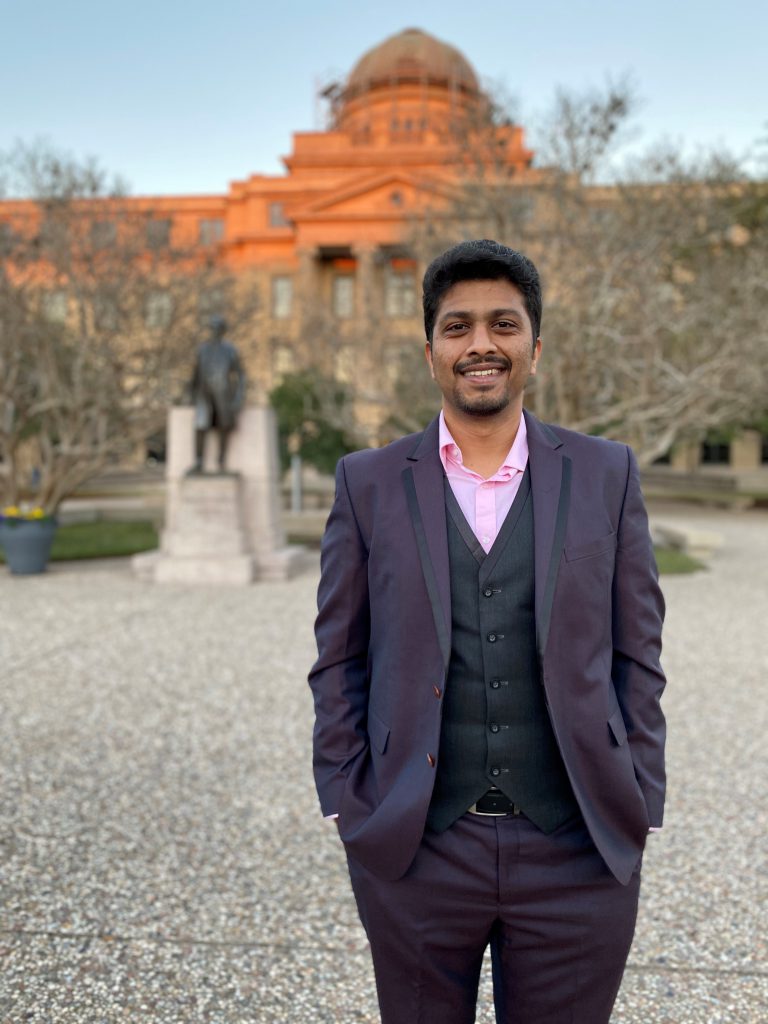
Abhishek Nayak is a Safe-D student at TAMU working on Safe-D Project 04-115: Reference Machine Vision for ADAS Functions and previously on Safe-D Project 03-051: Response of Autonomous Vehicles to Emergency Response Vehicles. Read his Safe-D Student interview below!
What are your research interests?
The goal of my research is enabling “perception” in autonomous vehicles. My research interests include the use of image processing, machine learning, neural networks and similar techniques to deploy machine-vision and develop vision-based control algorithms. I am currently involved in developing machine vision capabilities for both ground vehicles and smart infrastructures.
How did you end up participating on a Safe-D project?
I was part of CAST program at Texas A&M where I was working on a few projects that required me to develop computer-vision driven solutions. One of the projects was IEA (Infrastructure Enabled Autonomy) where I was developing machine vision capabilities for smart roadside units including vehicle identification and localization. When Safe-D Project 03-051: Response of Autonomous Vehicles to Emergency Response Vehicles got approved in Jan 2018, I was asked by Dr. Sivakumar Rathinam (PI) to work on it, as one of the main goals of the project was developing Emergency Vehicle detection and localization techniques. Later since Feb 2019 I have been working on another Safe-D project, Safe-D Project 04-115: Reference Machine Vision for ADAS Functions, which involves developing a reference benchmark for ADAS Lane detection systems (like Lane Departure Warning (LDW) and Lane Keep Assist (LKA) systems).
What is your role on the Safe-D project that you are working on? Describe what responsibilities you have, or will have, as a project team member.
I’m working on Safe-D Project 04-115: Reference Machine Vision for ADAS Functions which includes developing a reference benchmark for Lane Detection systems. Currently, there is no available standard or benchmark to evaluate the quality of either the lane markings or the perception algorithms used in lane detection (LD) systems. This project seeks to establish a reference test system that could be used by transportation agencies to evaluate the quality of their markings to support ADAS functions that rely on pavement markings. The test system can also be used by designers as a benchmark for their proprietary LD systems. As the project team member, my responsibilities include developing an extensive video dataset during different times of day and weather conditions on various roads in Central Texas. Using the video dataset, we evaluate the different state-of-the-art lane detection algorithms and rank their performance based on a set of metrics specifically developed for evaluating the effectiveness of the lane estimation system.
What do you like most about participating on this Safe-D project?
This project is a combined effort of researchers at TTI and Mechanical Engineering department at Texas A&M. We also have a group of researchers from The 3M Company onboard who are advising us on our research. What I like the most about this project is that we are building tools that can be actually used by industry professionals and government agencies to improve the overall safety standards required for transportation. We are looking at an overall systems approach which not only looks at the software side of an LD system but also the hardware (sensors) and infrastructure (pavement materials and lane markings) that contribute towards lane detection. I personally am researching different aspects of the LD software, how different materials aid towards improving LD, how changing weather conditions affect LD, etc. and how each factor affects each other.
What has working on this project allowed you to learn/do/practice?
I was mainly concentrating on the software side of things like improving the algorithms to solve computer vision-related problems in my previous projects. However, this project has made me realize that the hardware side also plays an equally important role. Going forward I’d like to incorporate a systems approach and consider every parameter involved in all my problem solving, not only limited to research. This project has also helped me improve my time management and people management skills as I have had to work with researchers from other departments and different backgrounds. This has helped me improve my knowledge of different aspects like material characteristics & testing, and at the same time share my knowledge.
How has/will this project benefit your education and future career goals?
I look forward to using most of the techniques I learn and the work I do on this project to contribute toward my dissertation. I have attended several talks and conferences and presented posters of my work and engaged in meaningful conversations with researchers and industry leaders on how our work with Safe-D has a real impact on improving transportation safety. I hope these conversations open future avenues for me to pursue a career in research.
Is your Safe-D project contributing to your thesis or dissertation? If so, when do you expect to complete your thesis/dissertation? If not, describe your thesis/dissertation topic and when you expect to complete it.
My Master’s thesis, ‘Development of vision-based response of autonomous vehicles towards emergency vehicles using Infrastructure Enabled Autonomy‘ which I successfully completed in December 2019, was mainly based on the work I did for the RAVEV Safe-D project. I haven’t finalized my Ph.D. dissertation topic yet, but I’m sure the work that I’m currently doing with Safe-D will form a part of my dissertation.
What are your career goals? If you are nearing graduation and have already taken an employment position after graduation, which institution will you be working for?
I recently graduated with a master’s degree in Dec 2019 and am currently pursuing a Ph.D. in the Department of Mechanical Engineering at Texas A&M University. So, my near future is fixed and hopefully, I’ll be working on more Safe-D projects. Upon graduating I plan to pursue a career in research, but I haven’t yet decided if it’ll be in academia, in a research lab, or industry.
The Safe-D Student and Faculty Interview Chain was created to encourage Safe-D students to facilitate contact with faculty and staff members participating on Safe-D projects via conducting a brief interview as a networking and career-building opportunity. To learn more about this initiative, please contact Safe-D Program Manager, Eric Glenn.
